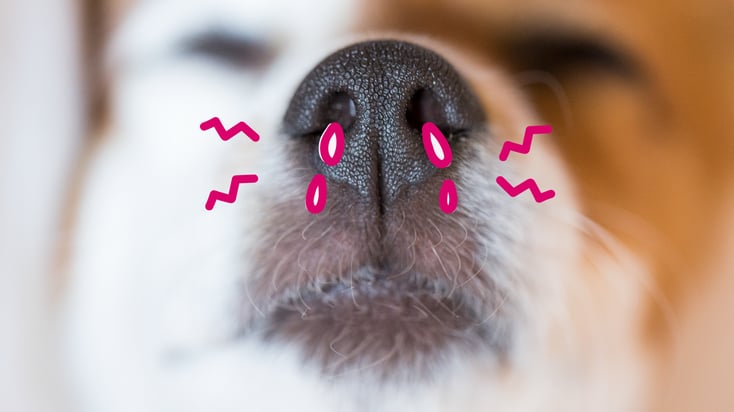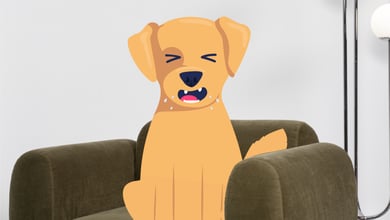Nasal Stenosis in Pets: Narrow Nasal Passages

Nasal stenosis is a treatable condition where the nasal passages of a dog or cat are abnormally narrow, thus causing symptoms in the respiratory tract due to a restriction of air. Nasal stenosis can be congenital (present at birth) or acquired later in life.
The nasal cavity extends from the nostrils to the back of the throat (also known as the nasopharynx). It can be broken into four regions: nasal vestibule, respiratory region, olfactory region, and nasopharyngeal region. These regions work together to facilitate breathing and smell.
Stenosis or narrowing can occur anywhere along the length of the nasal cavity.
Nasopharyngeal Stenosis In Dogs
Nasal passage narrowing in dogs can impact any of the regions of the nasal cavity.
Common areas affected are:
- Nares or nasal openings
- Nasal vestibule located just inside the nasal openings (nares)
- Nasal passages extending from the nares to the nasopharynx
- Choanae are the openings in the back of the nasal cavity before the nasopharynx
- Nasopharynx located at the upper part of the throat where the nasal cavity connect with the pharynx
Causes of Canine Nasal Stenosis
There are a number of causes for dog nasal passage narrowing, from genetic conditions and factors, to injuries and illness.
Some of the most common causes include:
- Brachycephalic Breeds/Congenital Factors
- Trauma
- Infections – bacterial, fungal, viral
- Tumors
- Foreign body
- Polyps
- Allergic rhinitis – inflammation caused by allergies
Symptoms of Nasal Stenosis in Dogs
While any of the symptoms below could be attributed to nasal stenosis in pets, they are not enough to make a definitive diagnosis.
Only a veterinarian will be able to determine if one or more of these signs is due to abnormal nasal passage narrowing:
- Exercise intolerance
- Noisy breathing
- Dyspnea – difficulty or labored breathing
- Snoring
- Cyanosis or bluing of the mucus membranes and skin resulting from inadequate oxygenation
- Fainting
- Mouth breathing
- Rhinorrhea or runny nose
- Gagging
- Epistaxis or nose bleeding
- Collapse
- Overheating due to inability to cool off through adequate respirations
Treatment Options for Dogs
If your pet is diagnosed with nasal stenosis, your veterinarian will make the best plan for your pet and explain any next steps. These may include:
- Surgery - may be the treatment of choice in many patients. The affected tissue will be excised, and the incision sutured.
- Balloon dilatation - a less invasive technique your veterinarian may use is balloon dilatation, by which a small balloon is inserted into the compromised nasal space and then slowly filled with air in order to widen the narrow passage.
- A stent may be placed to create a larger opening
- Antibiotics - to treat a bacterial infection or following surgery, or balloon dilation to prevent infection
Nasal Passage Narrowing in Cats
Nasopharyngeal stenosis in cats develops when there is blockage within the nasal cavity from inflammation, scar tissue, or physical obstruction.
Causes of Feline Nasal Stenosis
Nasal stenosis in cats can develop as a result of any of the following conditions:
- Upper respiratory infection – viral, bacterial, or fungal
- Chronic regurgitation or vomiting causing secondary inflammation
- Chronic rhinitis or inflammation secondary to allergies
- Presence of a foreign body
- Contact with irritants
- Nasopharyngeal polyp originating in middle ear
- Congenital deformity
Symptoms in Cats
A veterinary diagnosis of nasal stenosis in cats can be made through a physical examination and diagnostic testing and may include any of the following symptoms:
- Unusual nasal sounds (whistling or snoring)
- Difficulty breathing or dyspnea
- Sneezing
- Breathing through the mouth
- Decreased appetite
- Excessive nasal discharge or rhinorrhea
- Epistaxis or nose bleeding
- Difficulty Sleeping
Frequently Asked Questions
How do I know if my dog has stenotic nares?
Some common symptoms of stenotic nares include noisy breathing when active or at rest, snoring when asleep, difficulty breathing, mouth breathing, exercise intolerance, and nasal discharge. If you notice any of these signs occurring with your dog then it is best to have them evaluated by a veterinarian.
How do you treat nasopharyngeal stenosis in cats?
Depending on the underlying cause, treatment may consist of antibiotics, surgery, or balloon dilation.
Can a dog live with stenotic nares?
Depending on the severity of the stenosis determines the need for medical intervention. Some dogs with mild stenosis can live long normal lives while dogs with more severe stenosis can experience difficulties due to decreased airflow leading to symptoms of noisy breathing, exercise intolerance, and respiratory distress.
How do you treat nasopharyngeal stenosis in dogs?
Depending on the underlying cause, treatment may consist of antibiotics, surgery, or balloon dilation
How do I know if my dog needs stenotic nares surgery?
If you suspect your dog has stenotic nares then it is best to have them evaluated by a veterinarian to determine if surgery is the best option for your dog. It is better to act sooner rather than later as complications can worsen the longer the condition persists.






